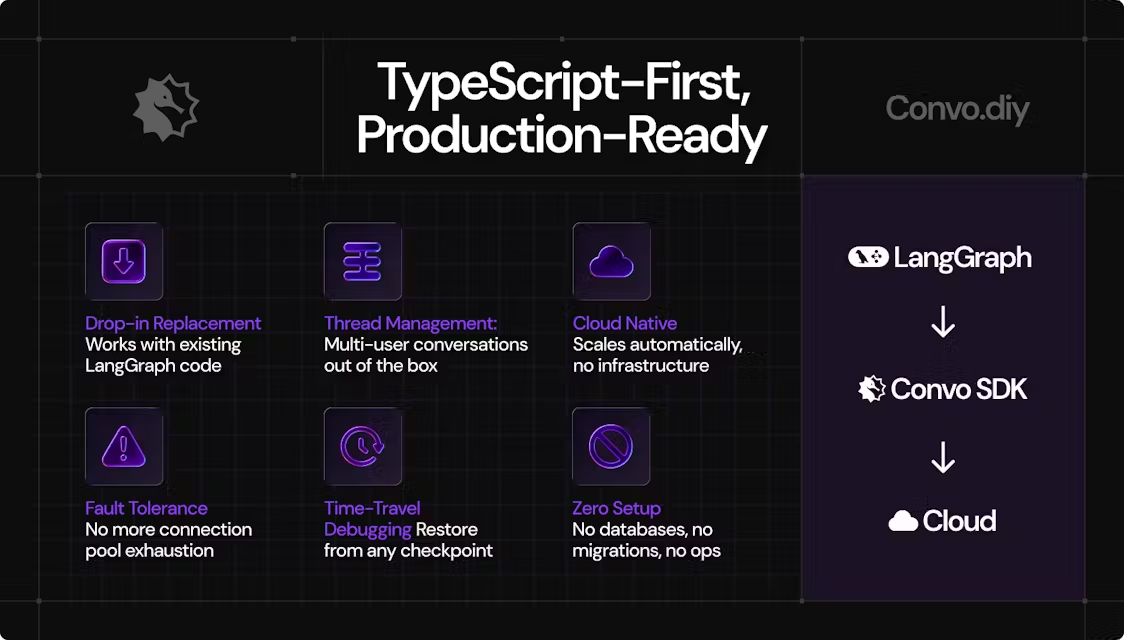Convo is a tool platform focused on AI agent development that helps developers quickly build, debug, and optimize AI agents based on the LangGraph of intelligent agents. It provides logging, state management, and multi-user memory capabilities through simple code integration, reducing the burden on developers for database configuration and infrastructure management.Convo's core goal is to enable AI agents to work out-of-the-box in production environments, with support for cross-session storage of user data, tracking of messages and tool invocations, and rapid recovery of operational state. The platform is designed to be simple and suitable for teams that need to efficiently develop reliable AI applications.

Function List
- Logging: Automatically capture every message, tool call and LLM output for developers to analyze and debug.
- Long-term memory: cross-session storage of user facts, preferences and goals to support personalized interactions.
- Multi-user support: Automatically manage conversation data for multiple users without additional configuration.
- Status Recovery: Built-in checkpoint function allows you to go back and recover the running status of the agent at any time.
- No database required: Provides out-of-the-box code solutions that eliminate complex configurations.
- Tool Integration: Support seamless connection with CRM, email marketing platform and other common tools.
- Debugging support: Quickly locate and resolve AI agent issues with detailed logging and status management.
Using Help
Convo is a tooling platform for developers, primarily integrated into LangGraph-based AI agent projects via an SDK. Below is a detailed user guide to help users get started quickly and take full advantage of its features.
Installation process
Convo is very easy to install, developers just need to integrate it into their projects via its officially provided SDK without additional configuration of databases or complex infrastructure. Here are the steps:
- Getting the SDK: Visit the Convo website (https://convo.diy/) and download the latest SDK packages from the developer documentation area. Detailed API documentation and sample code are provided.
- Project Integration::
- In your LangGraph project, add a Convo SDK dependency. For example, in a Python project, you can add a dependency on the Convo SDK via the
pip install convoInstallation (specific commands are based on the official website documentation). - Import the Convo module in your code, for example:
from convo import ConvoAgent - Initialize the Convo agent, passing in the necessary configuration parameters (such as the API key, which can be obtained after registering on the official website).
- In your LangGraph project, add a Convo SDK dependency. For example, in a Python project, you can add a dependency on the Convo SDK via the
- Configuration environment: Convo eliminates the need to manually configure the database, it handles data storage and state management automatically. All developers need to do is make sure the network connection is working and the API key is set up correctly.
- test integrationConvo provides test cases to help developers quickly verify functionality.
Once installed, developers can use Convo's features in their projects. The entire process usually takes only a few minutes, making it ideal for fast iterative development scenarios.
Functional operation flow
Below are detailed how-to guides for Convo's core features to help users get started quickly.
1. Logging
Convo automatically captures every message, tool call, and LLM output from the AI agent, eliminating the need for developers to manually log it. Operational Steps:
- Enable logging: When initializing the Convo agent, set the
logging_enabled=True. Example:agent = ConvoAgent(api_key="your_api_key", logging_enabled=True) - View Log: Detailed logs are viewed through a dashboard provided by Convo (accessible from the official website after logging in). The dashboard displays timestamps, message contents, tool call details, and LLM output.
- Exporting logs: Supports exporting logs to JSON or CSV format for further analysis. For example, click the "Export" button in the dashboard, select the format and download.
2. Long-term memory
Convo supports storing user data across sessions, ensuring that AI agents remember user preferences and historical interactions. Operational Steps:
- Stored Data: Calling stored methods in code, for example:
agent.store_memory(user_id="user123", key="preference", value="likes_dark_mode") - retrieve: Retrieves a memory by user ID, for example:
preference = agent.get_memory(user_id="user123", key="preference") - application scenario: Can be used for personalized recommendations. For example, the AI agent adjusts the interface theme or recommended content based on user preferences.
- Managing Memory: View and edit memory data for all users in the dashboard, with support for batch operations.
3. Multi-user support
Convo automatically manages multi-user conversations, eliminating the need for developers to manually configure them. Operational Steps:
- Assigning user IDs: Assign a unique ID to the user at each interaction, for example:
agent.handle_conversation(user_id="user123", message="Hello") - View User Data: Filter conversation logs by user ID in the dashboard to view the history of a specific user's interactions.
- Privacy: Convo ensures that user data is segregated to prevent cross-access.
4. Status recovery
Convo's checkpointing feature allows developers to go back and restore the operational state of the AI agent, suitable for debugging complex workflows. Operational Steps:
- saved state: Invoke checkpoint saving at key nodes, for example:
agent.save_checkpoint(run_id="run456") - restored state: Restore status by running ID. for example:
agent.restore_checkpoint(run_id="run456") - commissioning: View the checkpoint history in the dashboard, select the node you want to go back to, and click the "Restore" button.
5. Tool integration
Convo supports connectivity to external tools such as CRM or email platforms. Operational Steps:
- Configuring Connections: Add the tool's API key, such as that for Salesforce or Mailchimp, to the dashboard.
- invocation tool: Trigger external operations in code via Convo's tool call interface, for example:
agent.call_tool("send_email", recipient="user@example.com", content="Hello") - Verification results: Check the tool call log in the dashboard to confirm that the operation was successful.
6. Commissioning support
Convo provides detailed logging and status management to help developers quickly pinpoint problems. Step-by-step:
- Viewing Errors: Filter the "Errors" tab in the dashboard to view detailed error messages and stack traces.
- reproduce the problem: Use the state recovery feature to go back to the checkpoint before the problem occurred to reproduce and fix the bug.
- Optimization Recommendations: The dashboard provides performance optimization recommendations based on log analysis, such as reducing the number of LLM calls.
caveat
- network requirement: Convo's dashboards and API calls require a stable network connection.
- documentation reference: It is recommended to check the official documentation frequently for the latest API updates and best practices.
- Rights Management: Ensure that API keys are secure from disclosure.
By following these steps, developers can quickly integrate and utilize Convo's features to dramatically improve the efficiency of AI agent development.
application scenario
- AI Customer Service Development
Developers build intelligent customer service agents for e-commerce platforms.Convo's Long Term Memory feature records user purchase preferences, Logging feature tracks issues during conversations, and Status Recovery feature helps debug complex multi-round conversation flows. - Personalized Education Assistant
In educational applications, Convo stores student progress and preferences, and AI agents provide customized learning suggestions based on memory. Multi-user support ensures that different students' records do not interfere with each other. - Enterprise Automation Workflow
Organizations use Convo integrated CRM and email tools to automate customer inquiries. Developers quickly optimize workflows and reduce manual intervention with logging and checkpointing capabilities.
QA
- Does Convo need to configure the database itself?
No. Convo provides an out-of-the-box solution that automatically manages the data store and developers simply integrate the SDK. - How can I view the AI Agent's runtime logs?
Log in to your Convo dashboard on the Convo website, select the "Logs" tab, and filter for a specific user or time period to view detailed logs. - What external tools does Convo support?
Support for CRM, email marketing platforms and many other tools, the list of which can be viewed in the official website documentation. Integration is done via API key. - How do I restore the agent to operational status?
Use therestore_checkpointmethod, or select the checkpoint in the dashboard and click the "Recover" button.


































